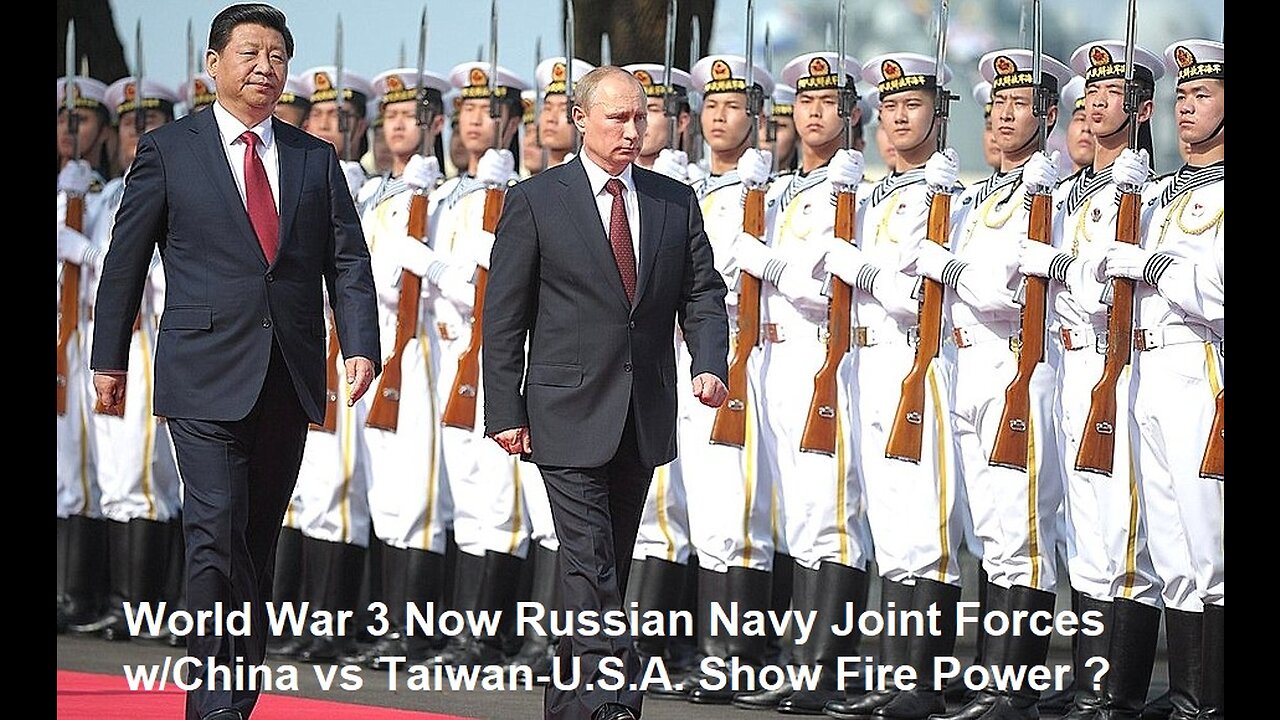Premium Only Content

World War 3 Now Russian Navy Joint Forces w/China vs Taiwan-U.S.A. Show Fire Power
China and Russia are signaling to NATO that they are willing to cooperate militarily and deepen diplomatic ties with joint naval maneuvers currently taking place in the Baltic Sea. Experts say China wants a global navy. A joint military exercise or is it for real by the Chinese and Russian navies today is underway off the coast of Qingdao in east China's Shandong Province. The week-long drills kicked off with both sides formally greeting each other. The Russian Navy possesses the vast majority of the former Soviet naval forces, and currently comprises the Northern Fleet, the Pacific Fleet, the Black Sea Fleet, the Baltic Fleet, the Caspian Flotilla, the Permanent task force in the Mediterranean, Naval Aviation, and the Coastal Troops (consisting of the Naval Infantry and the Coastal Missile and Artillery Troops).
Biden Administration got paid with Biden son and family help as planned with china and other is to emptying all the U.S.A. Strategic Petroleum Reserve below 10% by July forth 2023 World War 3 with Russian Navy and China vs Taiwan Soon.
Iranian, Russian, Chinese forces intercept, shoot at aerial targets in joint naval drill Naval forces from the Islamic Republic of Iran, Russia and China have practiced shooting at aerial targets during a nighttime operation over an area in the Sea of Oman, where the three countries are carrying out large-scale maritime maneuvers involving various divisions of their military forces.
The spokesman for the joint exercise, dubbed ‘naval security belt combined war game 2023’, stated that launching overnight strikes against hostile aerial targets was among the main tactics of the naval drill, which Iranian, Russian and Chinese forces successfully practiced late on Thursday.
Participants in the joint drill, including units from the Islamic Republic of Iran Navy, the Islamic Revolution Guards Corps (IRGC) Navy and flotillas from China and Russia, practiced attacks on various aircraft in close coordination and in accordance with a common tactical language, Rear Admiral Mostafa Tajoddini said.
Meanwhile, Iranian Navy Commander Rear Admiral Shahram Irani told Press TV that maritime security chiefly forms the basis of the joint naval drill, emphasizing that Iranian naval forces attach paramount significance to the safety of maritime navigation throughout the world. The focus of the first day of the naval security belt combined war game 2023 was on coordination, cooperation, rescue of vessels that have fallen prey to pirate attacks and how to counter acts of terror,” he said.
The Iranian Navy chief went on to describe combating maritime terrorism as one of the primary objectives of the naval drill, saying, “Presently, the unjustifiable presence of some foreign military forces continues to pose challenges to the region. The issue had to be addressed and handled. Therefore, all available military means, both in terms of watercraft and aircraft, were utilized and all designed drills were successfully exercised. Iranian naval forces, together with their Chinese and Russian counterparts, have held several joint war games in recent years with the purpose of improving the security of international maritime trade, countering piracy and maritime terrorism, exchange of information in naval rescue and relief operations, and exchange of operational and tactical experiences.
Australia’s fuel reserves don’t have to keep running on empty too. For decades, Australians’ faith in globalisation and economic liberalism ensured that discussions about resilience focussed on recovery from short-term disasters. But the impacts of Covid-19 and the exponential decline in global security in recent years have signalled that this faith may have been misplaced. Australia’s supply chains continue to be tested—and to challenge policymakers.
Our precarious liquid fuel arrangements are a case in point.
Liquid fuel currently meets more than half of the nation’s energy needs. Australia imports around 90% of its refined fuel. Despite this, its only two fuel refineries are under pressure to shut down due to the market’s preference for just-in-time supply chains.
Buying at the last minute can offer savings, but Covid has shown how vulnerable that practice is to disruptions. In the current geostrategic environment, vulnerability is dramatically increased. Australia is heavily reliant on refined fuel and the crude oil required for refining it transiting through an increasingly contested South China Sea.
The United States, China, Japan, India, South Korea and the United Kingdom have all agreed to release 680 million barrels of oil from their Strategic Petroleum Reserves in order to cool high prices and tame inflation. The Strategic Petroleum Reserve (SPR) is an emergency stockpile maintained by the United States Department of Energy (DOE). It consists of underground salt caverns in Texas and Louisiana that can hold more than 1,900 million barrels of oil, although it is not currently full. The reserve held almost 96 million barrels earlier this month, down from more than 617 million barrels at the about the same point last year.
The Strategic Petroleum Reserve (SPR), the world's largest supply of emergency crude oil was established primarily to reduce the impact of disruptions in supplies of petroleum products and to carry out obligations of the United States under the international energy program. The federally-owned oil stocks are stored in huge underground salt caverns at four sites along the coastline of the Gulf of Mexico. The sheer size of the SPR (authorized storage capacity of 714 million barrels) makes it a significant deterrent to oil import cutoffs and a key tool in foreign policy.
SPR oil is sold competitively when the President finds, pursuant to the conditions set forth in the Energy Policy and Conservation Act (EPCA), that a sale is required. Such conditions have only existed three times, most recently in June 2011 when the President directed a sale of 30 million barrels of crude oil to offset disruptions in supply due to unrest in Libya. During this severe energy supply interruption, the United States acted in coordination with its partners in the International Energy Agency (IEA). IEA countries released altogether a total of 60 million barrels of petroleum.
Additionally, the Secretary of Energy may authorize limited releases in the form of exchanges with entities that are not part of the Federal Government. This authority allows the SPR to negotiate exchanges where the SPR ultimately receives more oil than it released; thereby acquiring additional oil. With the exception of the 2000 Heating Oil Exchange, the SPR has entered into negotiated contracts at the request of private companies in order to address short-term, emergency supply disruptions to a refiner's normal operations on several occasions.
SPR Distribution Systems -The SPR Distribution Systems sites are connected to midstream assets within three distribution systems: Seaway, Texoma, and Capline. The Seaway System includes the Bryan Mound SPR site and connects to refinery hubs in Houston, Texas City, and Freeport. The Texoma System includes the Big Hill and West Hackberry SPR sites. Both Big Hill and West Hackberry have connectivity to the Beaumont-Port Arthur, Lake Charles, and New Orleans area refineries. The Capline System includes the Bayou Choctaw SPR site and connects to the Baton Rouge area refineries as well as one New Orleans area refinery. As of August 2020, the four SPR storage sites were connected by SPR owned pipelines and commercially owned pipelines and terminals, to 28 Gulf Coast area refineries and six refineries located in Michigan, Ohio, and Kentucky.
The SPR also connects to three marine terminals that have a combined contracted marine distribution capacity of 2.220 MMbbl/d, and it owns one marine terminal (leased to ExxonMobil Pipeline Company) with a distribution capacity of 400 Mbbl/d. These marine terminals are: Seaway Terminal (Enterprise Products), Freeport, Texas; Seaway Terminal (Enterprise Products), Texas City, Texas; Energy Transfer Terminal, Nederland, Texas; and the DOE-owned, St. James Terminal, St. James, Louisiana.
Australia’s lack of onshore fuel storage is a major weakness. As an International Energy Agency member since 1979, Australia should hold at least 90 days of net oil imports. Australia has been unable to match this commitment since 2012 due to a decline in its refining capacity and an over-reliance on just-in-time imports. As of June, Australia had 58 days of net import coverage, or 72 days in total, if the government added oil aboard vessels bound for Australia (a measure the IEA does not accept). One of the unseen challenges here is this arcane methodology for calculating onshore bulk fuel holdings.
Australia’s inability to meet minimum IEA requirements speaks to the broader energy resilience problem and was a likely factor behind the Morrison government’s three-part fuel security package. The package included the 2020 decision to store $94 million of oil in the US Strategic Petroleum Reserve. While that was welcome, the fuel is stored far from Australia’s bowsers. The package also included $260 million in grants to boost diesel storage by 40%, or 780 megalitres, in 2021.
National fuel calculations include bulk fuel storage by large end users such as mining or commercial entities. However, the ongoing operation of such facilities is driven by commercial decision-making around mining life cycles rather than Australia’s strategic resilience requirements. So actual fuel holdings can change quickly.
Facilities at the township of Gove in the Northern Territory illustrate the problems here. Mining giant Rio Tinto has been operating in Gove for more than four decades, establishing massive support infrastructure including storage for more than 160 megalitres of fuel. The company’s mining operations in Gove are expected to cease by 2030, however. Remediation work has already begun, including decommissioning the fuel storage. These plans will affect both local traditional owners and Australia’s fuel security, particularly in the north. It’s unclear if the government is tracking the projected impacts of industry’s closure of bulk storage facilities, especially as large-scale mines reach the end of their lives.
The previous government’s diesel storage initiative was a welcome step. More funding is needed to repurpose underutilised commercial sites like that at Gove which was not part of the 2020 grants program. However, there is a fresh proposal by the Airport Development Group and the Gumatj Aboriginal Corporation to recommission storage at the Rio Tinto Alcan Gove Fuel Farm. That would involve using five of the nine existing tanks which could hold between 120 and 160 megalitres of refined and unrefined fuel. Significantly, Rio Tinto Alcan is prepared to use its closure and rehabilitation budget to support this recommissioning. A decision is needed soon as demolition of surrounding buildings began earlier this year.
The Gumatj Aboriginal Corporation supports the Gove proposal. The company is a major employer of Gumatj and Yolngu people in Northeast Arnhem Land, and fought hard to win a 99-year lease in 2017. However, the planned closure of the Gove mine raised fresh concerns among traditional owners over unemployment and rehabilitation efforts. This includes the Rirratjingu people who are concerned about toxic red mud ponds and other caustic substances. Reopening the Gove facility will require in-depth consultations with traditional owners to ensure that their concerns over the environment, rehabilitation, governance, land ownership, traditional land rights and employment are fully considered.
A recommissioned Gove would provide one of the most extensive storage and commercial seaboard fuel terminals in Australia’s north. The facility could also complement initiatives like the $270 million investment to build a fuel storage facility in Darwin port’s East Arm, which will store 300 million litres of jet fuel to support US military activities.
Concerns about a deteriorating defence and security situation reinforce the case for using mining and commercial sites, like that at Gove, to store national strategic reserves. Reusing commercial sites to hold large reserves in the north and to boost Australia’s energy resilience makes strategic sense.
Biden announces historic oil reserve release and presses oil companies to do their part to reduce gas prices. President Joe Biden on Thursday announced an unprecedented release of oil from US reserves and several steps his administration is taking to punish oil companies for not increasing production from unused leases on federal land.
The steps are an attempt to reduce gas prices while also putting an onus on oil companies to increase supply. The dramatic step, which Biden announced from the White House, confronts what has become a looming political problem months ahead of the midterm elections.
“Our prices are rising because of (Russian President Vladimir) Putin’s actions. There isn’t enough supply. And the bottom line is if we want lower gas prices we need to have more oil supply right now,” Biden said.
The President added: “Your family budgets to fill a tank – none of it should hinge on whether a dictator declares war.”
The release would amount to 180 million barrels of oil. The President said it would act as a “wartime bridge” as US and global oil production ramps back up after the coronavirus pandemic. The decision was made in coordination with US allies overseas, including in Europe, though officials declined to say whether other countries were also releasing barrels from their reserves.
“Together, our combined efforts will supply well over a million barrels a day. Nations (are) coming together to deny Putin the ability to weaponize his energy resources against American families and families and democracies around the world,” Biden said.
The US will restock barrels in the reserve when oil prices are lower, the President said, which could help further incentivize production going forward.
Still, officials declined to say how quickly, or by how much, gas prices might come down as a result of the release. And they said they to address not focused on “immediate short-term price movements” in the oil market. Instead, they said their goal was addressing a lack of supply due to Russian oil coming off the market, adding that it would translate into providing relief for American consumers.
The President warned oil companies against exploiting the situation to increase profits.
“No American company should take advantage of a pandemic or Vladimir Putin’s actions to enrich themselves at the expense of American families. Investing those profits in production and innovation, that’s what they should do. Invest in your customers,” Biden said.
The President said the second part of his plan to address the rising prices is to create American energy independence in the long term.
“Ultimately, we and the whole world need to reduce our dependence on fossil fuels altogether. We need to choose long-term security over energy and climate vulnerability,” Biden said.
Biden earlier in the month announced a coordinated release of oil from the reserves in conjunction with other nations. He also released around 50 million barrels in November, which he said at the time was the largest release from the reserve in US history.
Neither move had a significant effect on gas prices, which have continued to rise as global limits on Russian energy exports have caused prices to spike.
The United States consumes around 20 million barrels of oil per day, with global consumption hovering around 100 million barrels. Biden’s planned releases would put more oil on the global market, potentially bringing down costs.
The President is also calling on Congress to “make companies pay fees on wells from their leases that they haven’t used in years and on acres of public lands that they are hoarding without producing,” one official said. For months, the Biden administration has publicly pushed back on the idea that regulations are holding oil producers back from more domestic production, pointing to millions of acres worth of land with approved permits for oil and gas production.
“Companies that are producing from their leased acres and existing wells will not face higher fees,” a fact sheet released by the White House reads, “but companies that continue to sit on non-producing acres will have to choose whether to start producing or pay a fee for each idled well and unused acre.”
Biden also will issue a directive to invoke the Defense Production Act to spur domestic production of critical minerals needed to manufacture batteries for electric vehicles and long-term energy storage.
The move from the White House adds critical minerals such as lithium, nickel, graphite, cobalt and manganese to the list of items covered by the 1950 Defense Production Act, a Korean War-era law allowing the President to use emergency authority to make large orders of a certain type of product or expand productive capacity and supply. It will allow the administration to support the production and processing of these critical minerals needed for a clean energy transition.
The Department of Defense will implement this authority, according to the White House, and will do so in consultation with tribal communities and using strong environmental, labor, and community standards.
China and Russia are signaling to NATO that they are willing to cooperate militarily and deepen diplomatic ties with joint naval maneuvers currently taking place in the Baltic Sea. Experts say China wants a global navy. According to NATO, a Chinese destroyer, frigate and supply ship sailed into the Russian harbor at Baltijsk located on the Baltic coast of the Russian exclave Kaliningrad on Friday. They are there to participate in joint naval maneuvers with Russia being dubbed "Maritime Cooperation 2017," which is set to last from July 24 to July 27.
This joint naval maneuver with Russia in the Baltic Sea is the latest display of China's geopolitical ambition as Beijing wants to increase its influence in international and strategic affairs.
China's emphasis on naval expansion is a sign of Beijing's awareness that becoming a world power first entails being a maritime power. For Russia, the maneuvers are a continuation of aggressive foreign policy and a display of strength on Europe's doorstep and the Baltic coast, where fears of Russian expansion are highest.
In 2015, China published a white paper outlining the importance of the navy for the future of the country. "It is necessary for China to develop a modern maritime military force structure commensurate with its national security and development interests […] so as to provide strategic support for building itself into a maritime power," reads part of the document.
According to a study written for the US Congress by Ronald O'Rourke, a US specialist in naval affairs, China has a series of strategic goals for its navy. At the top of the list is the possibility for military intervention in Taiwan followed by defending territorial claims in the South China Sea regulating its 200-mile maritime exclusive economic zone. Other ambitions cited by O'Rourke include displacing US influence in the Western Pacific and asserting China's status as a major world power.
Some of these goals are only possible for China if they develop a blue-water navy that is capable of worldwide operation. The United States is currently the only navy with such capability. China and Russia are still limited to operating in the waters near their coastlines. This is also why China is investing more resources in its navy than any other military branch.
"Although China's naval modernization effort has substantially improved China's naval capabilities in recent years, observers believe China's navy currently has limitations or weaknesses in certain areas, including joint operations with other parts of the military, antisubmarine warfare, a dependence on foreign suppliers for some ship components and long-range targeting," writes O'Rourke.
China is investing heavily in naval development, but is still behind the USA. China did build its first aircraft carrier, the Liaoning, in 2012 – but it is based on a Soviet model from the 1980s. The US is developing a new generation of aircraft carriers, including the $13-billion USS Gerald Ford. China also regularly protests against US naval maneuvers conducted under the international doctrine known as "preservation of freedom of the seas," where US ships sail through waters that are permissible by international law. The Chinese, however, dispute its validity.
In 2016, the former French defense minister declared that EU patrols could take place in the South China Sea within the boundaries of international maritime law.
China's participation in naval maneuvers in the Baltic Sea could be seen as a tit-for-tat.
Michael Paul, a senior fellow for international security at the German Institute for International and Security Affairs says the maneuvers illustrate China's ability to develop a fleet with the capacity to globally project power.
"Peaceful development is increasingly becoming more militarized and this is causing international concern as China's interests expand," Paul told DW. " Europe is beginning to feel this too."
It is somewhat ironic that China is now applying the same international law it rejects in the South China Sea to sail its naval vessels in the Baltic Sea. China's growing navy is also part of a larger realignment of foreign policy goals from Beijing.
In a report published by the Center for a New American Security, a US think tank, former Japanese Vice-Admiral Yoji Koda said that the People's Liberation Army Navy (PLAN) was increasing operations outside of its traditional areas of responsibility like the Yellow Sea, the South China Sea and the East China Sea.
Koda said the operations could "provide us with some hints about PLAN's new deployment strategy and operational concepts, as well as its revised naval doctrine."
China has participated in anti-piracy missions in the Gulf of Aden since 2008. In 2015, it took part in joint maneuvers with Russia in the Mediterranean Sea and the Black Sea. Chinese naval vessels are also being increasingly spotted in the Indian Ocean, the central Pacific and off the coast of South America. China has built a base in the small east-African country of Djibouti and there are reports in Indian media that China is planning to station naval assets in the Pakistani port of Gwadar.
"China's recent willingness to take extraordinarily strong unilateral steps to exercise its influence in maritime affairs is fundamentally related to its national objectives," said Koda in the report. "China often challenges established international norms and generates complicated dilemmas for the international community."
China and Russia have deployed ships and aircraft for the start of their joint military exercise, said to be the largest ever. The move comes amid a territorial dispute between Beijing and Tokyo. Military vessels stood ready in the waters off of the Sea of Japan on Friday for the launch of China and Russia's second naval drill. The week-long practice military maneuvers came over a year after the two countries' first joint exercise.
Chinese officials billed the event as the "largest military force" that China's navy had deployed for military drills with a foreign partner, according to the official Xinhua state news agency.
At least four Chinese destroyers, two latest-generation guided missile frigates and a support ship were to participate.
It was of great significance to Beijing and Moscow to improve "the capability to jointly address the maritime security threats and highlighting the firm determination to jointly safeguard world peace and regional stability," according to China's navy commander, Wu Shengli. The news agency AFP obtained the quote from the official Chinese Defense Ministry website.
China maintains the largest military influence over the region, seen by some as a valuable ally and by others as a continued threat. During heightened tensions between North and South Korea this year, international leaders looked to Beijing to dissuade North Korea from launching a war.
However, in issues of territorial dispute, neighboring countries, such as Japan, are wary of China's intensions. Over the past year, China has sent naval vessels on numerous occasions to a disputed island chain, called Diaoyu by China and Senkaku by Japan, in the East China Sea. Tokyo has refuted Beijing's territorial claims.
The Strategic Petroleum Reserve Is At Its Lowest Level Since 1984 What is the U.S. Strategic Petroleum Reserve (SPR)? What are the implications of depleting the SPR, which the U.S. has been doing now since 2016? Further, what has been the impact of the rapid drawdown of the SPR that has taken place this year? Let’s discuss. In December 1975, with memories of gas lines fresh on the minds of Americans as a result of the 1973 OPEC oil embargo, Congress established the Strategic Petroleum Reserve (SPR). The law was designed “to reduce the impact of severe energy supply interruptions” such as that caused by the embargo.
Over time the U.S. government began to fill the reserve. At its high point in 2010, the level reach 726.6 million barrels. Since December 1984, the level has never been lower than 450 million barrels — until now.
Some have noted that the SPR is less important than it once was. U.S. shale oil production has enhanced American energy security and lessens the importance of the SPR by reducing our dependence on imports. Consider that in 2005, the U.S. imported 10.1 million barrels per day (BPD) of crude oil, of which 4.8 million BPD (~48%) came from OPEC. The SPR contained 685 million barrels. With the U.S. importing 10.1 million BPD of crude oil at that time, that was enough oil to cover 68 days of supply. In 2021, the U.S. imported 6.1 million BPD, of which only 800,000 BPD came from OPEC. More importantly, a lot of that imported oil was refined and re-exported as finished products. Net imports of U.S. crude oil and finished products were actually -62,000 BPD (i.e., the U.S. was a net exporter).
Thus, one could certainly argue that the SPR is of less strategic importance than it once was, and that perhaps we no longer need a 700 million barrel reserve of oil.
President Biden Taps the SPR
On March 31, 2022 — in an attempt to fight higher oil and gasoline prices — President Biden announced the release of one million barrels of crude oil a day for six months from the SPR.
I remember when I first heard about it, I thought “Wow. That’s a lot.” In fact, I noted in interviews at the time that this level of release would likely help stem oil prices — at the risk of depleting our insurance policy in case of a supply disruption.
Consider that with the U.S. producing 12 million BPD, an extra one million BPD pushes total U.S. “supply” (which isn’t sustainable, because it relies on depleting the SPR) back up to the all-time pre-Covid high of 13 million BPD.
Politics of the SPR
Ultimately, drawing down the SPR was a political decision. Think about it. An administration that has frequently emphasized the importance of reducing carbon emissions is trying to increase oil supplies to bring down rising oil prices — which will in turn help keep demand (and carbon emissions) high.
But even though the Biden Administration wants to address rising carbon emissions, high gasoline prices cause incumbents to lose elections. So, they try to tame gasoline prices even though it contradicts one of their key objectives of reducing carbon emissions.
The SPR has now been depleted since President Biden took office from 640 million barrels to 450 million barrels. This depletion is consistent with recent history. Historically SPR volumes tended to grow during Republican administrations and to fall during Democratic administrations. That pattern has held true since 1980.
Presidents Clinton and Obama both used the SPR to try to ease high gasoline prices around election time, while Republican presidents (until Donald Trump) added to the SPR. President Trump drew down about 10% of the SPR during his term.
President Biden has announced steps to replenish the SPR, “likely after FY2023”, and in my opinion most likely after the 2024 elections. President Biden’s gamble to deplete the SPR in order to fight high oil prices may not hurt him at all. Of course, if for some reason we had a true supply emergency and found ourselves needing that oil, it would be looked upon as a terrible decision.
How the U.S. Force Is Losing Its Joint Advantage over China and Russia and 6 Other Country Against U.S.A.
Since the implementation of the 1986 Goldwater-Nichols Act (GNA), the U.S. military has held a particular operational advantage over potential adversaries with respect to joint interoperability. That advantage is the ability to conduct operations that are truly joint, where forces from different services work interoperably and interdependently. However, in recent years, the U.S. military has taken steps that threaten to undermine this advantage by weakening the very reforms that have lifted the joint force. Among other things, it has diluted joint education and curtailed joint duty assignments while adversaries such as China and Russia are slowly but steadily enhancing their ability to plan and conduct joint operations. To preserve its joint advantage, the U.S. military must reverse this trend and recommit to building military leaders who can think jointly, operate jointly, and lead jointly. Without a renewed emphasis on joint officer development, the United States stands to cede competitive space to global adversaries such as China and Russia.
The Joint Imperative
Jointness is not automatic and it is perishable. It must be advanced through continual joint force development efforts.
—Joint Publication 1, Doctrine for the Armed Forces of the United States1
As stated in the 2014 Army Operating Concept, “American military power is joint power”; it is through joint operations that the U.S. military achieves objectives set by the national command authority.2 With the GNA and subsequent reforms, Congress’s aim was to strengthen the ability of the U.S. military to plan and execute joint operations. Joint operations rely on the unique capabilities of each service ranging from combat platforms, warfighting organizations, and most important, joint-minded leaders for each mission. Rarely does a crisis lend itself to the capabilities of a single military service, and this means the forces from each must collaboratively orient toward common objectives rather than each fighting a separate campaign. Through the effective conduct of joint operations, the U.S. military is able to achieve success during times of conflict, and when it operates jointly and simultaneously through all domains and around the globe, adversaries have few military options to counter our actions.
It took the United States three decades to build the joint operational-level advantage it possesses today. More than simply establishing joint commands and assigning officers from the various services into joint billets, the Department of Defense (DOD) deliberately institutionalized key enablers for joint operations. This included developing organizations to produce joint concepts and doctrine, conducting several major joint exercises annually to hone the readiness of the joint force to carry out wartime missions, and maintaining a robust inventory of lessons learned from joint operations and exercises.3 Most important, the DOD learned the importance of instilling jointness in the minds of officers through joint professional military education (JPME) and subsequent joint duty experience. This is because JPME and joint duty are central to fostering the interpersonal trust that underwrites interdependence between forces of different services. These reforms have created a joint force of unprecedented capability, a result that our strategic competitors have recognized and are now endeavoring to achieve as well.
The Rise of China as a Joint Threat
Since assuming the office of president of the People’s Republic of China, Xi Jinping has emphasized the importance of improving joint operations in the People’s Liberation Army (PLA). Recent reforms moving the PLA toward more effective joint operations include changes to training, personnel, concept development, and organization.4 By drawing lessons from past U.S. military operations—Desert Storm, Kosovo, and the initial invasion of Iraq in 2003—Xi and senior PLA leaders concluded that victory in warfare is achieved through joint operations. In its 2019 annual report to Congress, the DOD outlined multiple ways in which China seeks to restructure its military to improve jointness. For example, the PLA recently published the Outline of Training and Education that emphasizes joint training in all domains and increased training through multiservice exercises, maneuvers, and mobility operations.5 Further, according to the authors of a recent National Defense University publication, China is also reorganizing its command structure through the establishment of five theater commands, each responsible for developing joint operational plans. Though domestic in nature, this bears a striking resemblance to the arrangement of the U.S. combatant commands under the Unified Command Plan.6
The PLA leadership understands the operational imperative of its military in a conflict with another nation is not the total destruction of an adversary’s armed forces. Rather, victory lies in the destruction of warfighting potential, ranging from strategic leadership to communications infrastructure. Attaining these goals or destroying these target sets requires the integration of long-range fires and effects across each branch of service and across all domains.7 Through such reforms to the PLA, China seeks to create a force capable of “complex joint operations.”8 Moreover, PLA leadership is focusing greater attention on both joint training and joint education to build the capacity of military officers to command and control joint operations.9
China is not yet at the threshold of surpassing the U.S. military’s capability to conduct joint operations. The United States has a deep bench in experienced and educated joint officers, not to mention joint doctrine and operational concepts, and these are capabilities that China still lacks. Further, China is moving toward an integrated joint fires system and advancing toward a joint logistics and joint acquisition enterprise.10 It is prudent for the United States to continue to monitor China’s advance toward a military capable of joint operations with the assumption the PLA will mirror current U.S. joint capability by 2035.11
The Steady Russian Advance
After years of neglect and underinvestment, Russia’s advance toward a more capable and effective force began in earnest in late 2008. In the decade following the collapse of the Soviet Union, the Russian military had minimal funding with which to man, train, and equip its units. Early indications of this underinvestment came to the forefront in 1994 with the feeble and haphazard performance by the Russian military in Chechnya. This circumstance persisted over the next decade and a half during operations in Kosovo in 1999 and later in the Republic of Georgia in 2008. In the latter, the Russian military was able to achieve strategic objectives, but this success was attributable more to the use of overwhelming force and capability overmatch than a more effective military force. The performance of the Russian military in Georgia prompted broad reforms to create a more capable and professional force.12 Although the reforms included changes to professional military education, they principally aimed to improve military efficacy through restructuring of the Russian military.
By operating jointly, the Russian military stands to create unique operational advantages through its more diverse range of militarized forces. In her book Russia’s Military Revival, Bettina Renz details how the Russian approach to joint military operations is not entirely analogous to the U.S. concept of jointness, which usually involves the participation of forces from two or more military services.13 To understand Russian joint operations, one must comprehend Russian force structure and how it starkly differs from that of U.S. military and those of many states. While the Russian military has the traditional armed forces with army, air force, and naval components, Moscow’s military efforts can also incorporate other nontraditional militarized forces such as the Federal Security Service, the Interior Ministry, and the Ministry for Emergency Situations. This arrangement follows a different paradigm and is not well understood by many in the U.S. military. Under this structure, the Russian military can directly leverage nontraditional forces and capabilities in circumstances that would require the U.S. military to be subordinated under another interagency department. For example, the Ministry for Emergency Situations, a component of the Russian military, is the lead for foreign humanitarian assistance, whereby any U.S. military involvement in the same would be under the auspices of the U.S. Agency for International Development.14 This broad range of forces enables Russia’s military to conduct joint military operations against adversaries across a broad spectrum of activities and well below the threshold of armed conflict.
Moscow’s intervention in Syria demonstrated to the world the Russian military’s increasing capability to conduct joint combat operations. According to the research of Tim Ripley, as discussed in his book Operation Aleppo: Russia’s War in Syria, throughout its involvement in the Syria conflict, the Russian military integrated its land, air, and maritime forces to mass effects against forces opposing the Syrian regime. Facilitating this, Russia set up a joint command and control center ironically named “Central Command” (or “Centcom”) to provide unity of command over its forces. This facility was also a combined Russian, Iranian, and Syrian headquarters that coordinated the efforts of three armies, two air forces, and one navy.15 Russia’s joint operations in Syria served as both a laboratory and a showcase for the growing ability of Russia’s military to operate as a joint force. Russian forces continually operated close air support; ground maneuver; and long-range land, air, and maritime strikes in a concerted effort to achieve operational objectives.16
Russian joint operations in Syria and the increasingly larger and complex Zapad (West) joint military exercises signal that Moscow’s forces will not be pushovers should the United States and NATO partners decide to engage them on a battlefield in the future. However, as with the PLA, the Russian military does not currently pose wide-ranging and significant challenges to the overmatch enjoyed by the United States. After the reforms of the last decade, the Russian military has become smaller and remains very limited in its force projection capability. However, restructuring and targeted investments are producing a force that is much more effective and ready, and this trend is expected to continue in the years ahead.17
The United States–Standing Still or Moving Backward?
PME [Professional Military Education] has stagnated, focused more on the accomplishment of mandatory credit at the expense of lethality and ingenuity. … PME is to be used as a strategic asset to build trust and interoperability across the Joint Forces and with allied and partner forces.”
—Summary of the National Defense Strategy18
Few would disagree that the reforms under the GNA and subsequent legislation have enabled the components of the U.S. joint force to operate better, gaining in both efficiency and effectiveness. However, rather than improving on these gains, in recent years, the U.S. military now appears to take jointness for granted and has worked to weaken many mechanisms that have lifted the joint force. These missteps manifest most saliently in the areas of joint education, duty, and organization.
Joint education. The DOD appears to have lost its way in ensuring military officers receive quality and timely joint education. It has largely succeeded in obfuscating the intent and focus of a critical phase of joint education by accrediting myriad senior-level organizations for delivery of JPME Phase II (JPME II). Most of these programs and institutions exist for purposes far apart from joint education, and their accreditation creates tension between serving their particular service or specialty focus and the requirements for a truly joint curriculum and experience. The chairman of the Joint Chiefs of Staff’s policy for joint education does little to assure consistent emphasis in joint content and approach across these programs, and despite its intended and legislated purpose, this phase of joint education is now widely misunderstood, becoming many different things to many different people.19 In short, there is absolutely no basic common core of content that institutions must cover in the JPME II curriculum. Further, a 2008 policy change no longer requires officers to receive this phase of JPME before serving in their first joint assignment, despite the preparatory intent for the education.20 According to RAND, the disordering of joint education and joint duty has now become endemic in practice.21 Despite explicit warning by Congress in 1989, JPME II is now seen by the Services as simply a “check the box” requirement for promotion to flag or general officer.22
Joint duty. In another step backward, the DOD also diminished the value of joint experience to officer development. With the passage of the National Defense Authorization Act in 2017, the DOD succeeded with a legislative initiative to substantially reduce the amount of time required of officers serving in a joint assignment to receive joint duty credit. While the change helps to increase the number of joint-qualified officers on the books—a cosmetic improvement—the measure severely shortchanges the joint experience acquired by officers and saddles combatant commands with increased personnel turnover and staff inefficiency. Additionally, some services delay assignment of their officers to joint billets until after those have met their service requirements for promotion to O-6 (Army colonel or Navy captain). This adds to beliefs that joint duty matters only when it comes to promotion. In fact, it encourages officers to avoid joint service as long as they possibly can, serving instead in the assignments their service values most. Together with the changes to JPME, the DOD is taking a quantity-over-quality approach to joint officer development.
Joint organization. With respect to joint force structure, the disestablishment of Joint Forces Command in 2011 represents another unfortunate setback to the joint advantage of the U.S. military. Not only did the action eliminate a powerful advocate for jointness, but it also eliminated the operational control the joint command exercised by law over the forces assigned to it.23 This left the preponderance of U.S. conventional military forces under the exclusive control of their respective services—a circumstance that continues today. It was the intent of Congress in 1986 that, with few exceptions, all forces shall be assigned to the unified commands in order to reduce the parochial influence the services exerted in past joint military operations. A key architect of the GNA reforms and author of Victory on the Potomac: The Goldwater-Nichols Act Unifies the Pentagon, James Locher III, testified to the Senate Armed Service Committee in 2015 that this circumstance risks “returning to the service separateness that crippled military operations prior to the Goldwater-Nichols Act.” Yet, in 2017, the DOD sought and succeeded in legislative change preserving the circumstance of service-retained forces.24
With these events as a backdrop, it seems unlikely that the United States is on track to sustain, much less build upon, the competitive joint advantage it enjoys over potential adversaries. It is time for the DOD to pause and reflect.
Consequences
The ability of the U.S. military to employ each component of the joint force, synchronized in time, space, and purpose, is paramount to maintaining overmatch over adversaries in time of conflict. The United States has witnessed past failures by its military services to operate as a joint team. Operation Eagle Claw, the failed rescue of the hostages in Iran, serves as one example. Casualties in the invasion of Grenada serve as another painful reminder of the price paid when the services fail to operate jointly. So it seems illogical, if not nonsensical, that in the face of contemporary security challenges the U.S. military would diminish, rather than to preserve or expand upon, the various GNA reforms that created the finest military force in history.
While the specific consequences of the U.S. military’s incremental retreat from jointness are hard to discern in advance, three outcomes are likely. The first is that negative effects on the joint force resulting from these changes, while unquantifiable, are all but certain. With increased service influence on joint operations and combatant command staffs increasingly manned by officers ill-prepared for joint duty and who will turn over more often, we should expect more ill-fated mistakes by the joint force to include deadly ones. Our not-too-distant history reminds us of this.25 The second outcome is that the joint force and the DOD will be slow to recognize these problems and their underlying causes. Moreover, the operational implications of departmental efforts to weaken GNA reforms may go undiagnosed for a very long time and perhaps will come to light only after a succession of military operations beset by parochial attitudes and joint incompetence during both planning and execution. Finally, once the problem is properly diagnosed, if ever, there will be an instinctive resistance by the department to earnestly identify and meaningfully address the challenge, especially when other priorities abound. This is because the GNA reforms to joint education, duty, and organization, while having only modest advocacy in the joint staff, have little substantive advocacy within the powerful services. Congress had to force much-needed reforms on the DOD in 1986 and will need to do so again if the department succeeds in continuing its efforts to undermine the mechanisms that have enabled the joint force to become what it is today. Conclusion
A thirty-year head start in building joint competency was not the choice of the U.S. military; rather, it was effected forcibly by Congress through legislation. Discerning and thoughtful members of Congress recognized the fiascos of Vietnam, the Mayaguez incident, and the deadly mistakes in Operation Urgent Fury and Eagle Claw for what they were. In response, they drove institutional change in the DOD and against the unified opposition of the Joint Chiefs of Staff.
The realization that the military fights as a joint force is a key part of the officer maturation process. Joint duty and education are not zero-sum options; they are not wasteful drains on service resources. The ability to put aside service parochialism to capably plan and execute as a joint team is a force multiplier for forces operating at the tactical and operational levels of war. Doing so requires quality and timely joint education, depth of joint experience, and effective joint organization before forces and functions are brought together in time of crisis. The joint advantage enjoyed by the U.S. military is highly perishable and must be cultivated continuously. If we expect to win the first battles of the next war, the department must reaffirm its commitment to improving the capability and capacity of the joint force.
Japanese, Korean Fighters Scrambled in Response to Joint Russia-China Bomber Patrol Four Russian Tu-95MS bombers and two Chinese H-6 bombers conducted a joint patrol over the Sea of Japan Wednesday, prompting fighter scrambles by Korea and Japan in response.
The joint patrol was the most recent one since May this year, which occurred the same day U.S. President Joe Biden met his Australian, Indian and Japanese counterparts in Tokyo, though both the Russian and Chinese defense ministries stated the flights in May were part of their annual military cooperation plan and not intended to be provocative.
On Wednesday morning, two Chinese H-6 bombers were confirmed to have flown from the East China Sea through the Tsushima Strait into the Sea of Japan before heading north, according to the Japanese MoD. Around the same time, two Russian aircraft flew south before turning back and heading north. Japan Air Self-Defense Force (JASDF) fighter aircraft scrambled in response, according to a statement from the MoD. According to Korea’s Yonhap News Agency, the Republic of Korea’s (ROK) Joint Chiefs of Staff (JCS) said Wednesday a total of two Chinese H-6 bombers, four Russian Tu-95 bombers and two Russian Su-35 fighters entered the Korea Air Defence Identification Zone that day with the Chinese bombers entering twice on their own and once with the Russian aircraft. The JCS stated that Republic of Korea Air Force fighters scrambled in response, but the Russian and Chinese planes did not violate ROK airspace.
The JCS said that the two Chinese H-6 bombers entered the Korean ADIZ at 5:48 a.m. local time, in an area 78 miles north of Leo Islet, a submerged rock south of Jeju Island, and left at 6:13 a.m. Following this, the H-6s entered the ADIZ from an area northeast of the port city of Pohang at 6:44 a.m. before exiting at 7:07 a.m. The two Chinese bombers and the four Russian bombers and two Russian fighters then flew together into the ADIZ from an area 125 miles northeast of the ROK’s Ulleung Island at 12:18 p.m. before exiting at 12:36 p.m. Both Russia and China do not recognise the Korea ADIZ.
Russia’s Defense Ministry said in a Wednesday release that the air forces of Russi and China conducted a joint air patrol in the Asia-Pacific region, adding that an air group of Russian Tu-95MS bombers and Chinese H-6 bombers carried out air patrols over the waters of the Sea of Japan and East China Sea.
The Russian bombers were in the air for eight hours, and the combined air group was escorted by Russian Su-30SM and Su-35S fighters, according to the release. Foreign fighter aircraft flew escort on the air group on occasions on the flight route, although the MoD did not state which countries these fighters came from. The release also stated that for the first time in the course of joint air patrols, Russian aircraft landed at an airfield in the People’s Republic of China and Chinese aircraft at an airfield in the Russian Federation though it did not give the locations where this took place.
The Russian MoD also said the aircraft of both countries acted in full accordance with the provisions of international law and there were no violations of the airspace of third countries, according to the release. Upon completion of the joint air patrol, the aircraft involved returned to their home bases. The patrols were carried out as part of the military cooperation plan for this year and are not directed against third countries. China’s Ministry of National Defense issued a brief statement on Wednesday about the joint operation.
“According to the annual military cooperation plan between the Chinese and Russian militaries, on November 30, the air forces of the two countries organized a routine joint air strategic patrol over the Sea of Japan, the East China Sea, and the western Pacific Ocean,” according to the statement.
Chinese ships have also sailed through the Tsushima Strait as well this week.
At 5 p.m. Monday, a People’s Liberation Army Navy frigate was sighted sailing northeast in an area 93 miles southwest of Tsushima with the image and hull number identifying the frigate as CNS Huanggang (577), according to a Tuesday JSO release.
A PLAN destroyer was sighted 9 a.m. Tuesday sailing northeast in an area 20km southeast of Tsushima. Image and hull number provided in the release identified the destroyer as CNS Taizhou (138).
Both Taizhou and Huanggang then sailed northeast through the Tsushima Strait into the Sea of Japan. The Japan Maritime Self Defense Force destroyer JS Setogiri (DD-156) and JMSDF P-1 Maritime Patrol Aircraft of Fleet Air Wing 4 based at Naval Air Facility Atsugi, Honshu shadowed the PLAN ships, according to the release.
China's World War 3 plan using coronavirus to conquer and rule the world
We, however, are hardly aware of the reality that the third world war has already commenced. The strategy adopted by China is being explained here. With the world on its knees before the deadly coronavirus COVID-19 outbreak, China has virtually launched World War III through its financial might to topple global powers like the United States and other European countries. These powerful countries are struggling to contain coronavirus and China is making full use of the mayhem across the world as it implements its strategy for World War III.
China started preparations for this World War long back. But today, after 75 years of World War II, this war has commenced without the use of any weapon, missiles or atom bombs but through a virus. The virus which weighs millions of times less than the mass of a nuclear bomb that in 1945 destroyed Japan's two major cities - Hiroshima and Nagasaki in the Second World War.
China has adopted a carefully calibrated strategy for World War III where the weapon is a virus.
The first step is to cheat the world; the second phase is through spreading chaos across the world, and the third stage is to oppress and exploit the world.
In a world war, one sees death, destruction and sorrow everywhere followed by the collapse of major economies, a decrease in the supply of essential commodities, the occupation of new territories, and the emergence of new forces.
You can notice these developments when around 2.7 million people across the world have been infected with coronavirus, while over 1.94 lakh people have died and the most powerful nation - United States of America - looks helpless before this deadly virus. More than 8 lakh people have been infected in the US and the death toll has reached over 50,000. Known for its military and economic might, the US is unable to save the lives of thousands of its people.
The deadly virus has also hit other rich and developed countries like Italy, Spain, Germany, and Britain. On the contrary, China is taking advantage of this opportunity and investing in the whole world and buying big companies at cheap prices.
With a huge shortage of equipment and medicines across the world, China is now supplying inferior medical equipment to the nations and is earning massive profit in the midst of this pandemic.
China started by trying to influence the World Health Organization (WHO), besides increasing its activities in the South China Sea. When the world is struggling with the deadly virus, China is busy in carrying out its expansionist policies. China has made full preparations to snatch power from America, knowing well that it can not defeat it in a direct war.
In World War III, China has strategised to execute its plan in three stages. The first step started with its economic liberalism in the 1980s when it opened the doors of its economy.
China has now moved into the second phase, which is to create chaos all over the world. The coronavirus has infected over 27 lakh people and has killed more than 1.94 lakh people. While chaos is visible across the world, China is benefiting the most. Now countries like America fear that if China withdraws its loan given to it then the US economy will face a major crisis.
China has planned to win this war by 2049 at any cost. According to famous political scientist Graham Allison, the first phase will complete in 2025 when China will make itself the world's superpower of technology. By 2035, China wants to become the innovation leader of the world, and by 2049, the Communist nation wants to make itself the most powerful country in the world.
-
 57:54
57:54
What If Everything You Were Taught Was A Lie?
13 days agoA Complete Guide To Expose Russia Gate Conspiracy Timeline Will Shock You Open Your Eyes Now
2.18K14 -
 LIVE
LIVE
The Bubba Army
22 hours agoDiddy Asks Trump For Pardon- Bubba the Love Sponge® Show | 8/06/25
5,667 watching -
 55:44
55:44
Game On!
16 hours agoCJ Stroud's MAKE or BREAK Season with the Texans?
5.12K1 -
 47:58
47:58
BlaireWhite
18 hours agoEpstein Survivor Interview: Exposing Everyone and Everything
10.3K13 -
 21:56
21:56
Producer Michael
19 hours agoI JUST BOUGHT $1,000,000 OF NEW CARS!
10.6K3 -
 2:56
2:56
Blackstone Griddles
13 hours agoHow to Clean your Blackstone Griddle with Bruce Mitchell
14K4 -
 8:07
8:07
Freedom Frontline
15 hours agoDan Goldman Just Got EXPOSED With ONE Video He Wasn’t Ready For
10.4K3 -
 LIVE
LIVE
BEK TV
23 hours agoTrent Loos in the Morning - 8/06/2025
261 watching -
 8:09
8:09
The Shannon Joy Show
14 hours ago🔥There Is No Golden Age: Trump’s Renter Society Is the Scam🔥
10.9K23 -
 11:23
11:23
True Crime | Unsolved Cases | Mysterious Stories
20 hours agoFound Inside a Gym Mat – 5 Mysterious Unsolved Cases (with Video Footage)
16.2K3